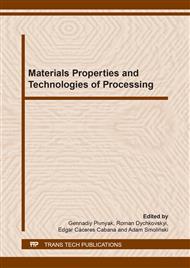[1]
Jouybari, H.J., Saedodin, S., Zamzamian, A., Nimvari, M. E., & Wongwises, S. (2017). Effects of porous material and nanoparticles on the thermal performance of a flat plate solar collector: An experimental study. Renewable Energy, (114), 1407-1418.
DOI: 10.1016/j.renene.2017.07.008
Google Scholar
[2]
Malvè, M., Bergstrom, D. J., & Chen, X. B. (2018). Modelling the flow and mass transfer in a mechanically stimulated parametric porous scaffold under fluid-structure interaction approach. International Communications in Heat and Mass Transfer, (96), 53-60.
DOI: 10.1016/j.icheatmasstransfer.2018.05.014
Google Scholar
[3]
Liang, Y., Wu, D., & Fu, R. (2013). Carbon microfibers with hierarchical porous structure from electrospun fiber-like natural biopolymer. Scientific reports, (3), 1119.
DOI: 10.1038/srep01119
Google Scholar
[4]
Säckel, W., & Nieken, U. (2016). Structure Formation within Spray-Dried Droplets; Mathematical Modelling of Spray Polymerisation. In Process-Spray, 89-125.
DOI: 10.1007/978-3-319-32370-1_3
Google Scholar
[5]
Lowell, S., & Shields, J. E. (2013). Powder surface area and porosity (Vol. 2). Springer Science and Business Media.
Google Scholar
[6]
Cheilytko, A.A., Ilin, S.V., & Nosov, M.A. (2017). Creation of effective metallic thermal insulation constructions. Naukovyi Visnyk Natsionalnoho Hirnychoho Universytetu, (6), 103-108.
DOI: 10.29202/nvngu
Google Scholar
[7]
Yatskov, M., Korchyk, N., Budenkova, N., Kyrylyuk, S., & Prorok, O. (2017). Development of technology for processing liquid iron-containing wastes of steel surfaces etching. Eastern European Journal of Advanced Technology, 2(6), 70-77.
DOI: 10.15587/1729-4061.2017.97256
Google Scholar
[8]
Eom, J. H., Kim, Y. W., & Raju, S. (2013). Processing and properties of macroporous silicon carbide ceramics: A review. Journal of Asian Ceramic Societies, 1(3), 220-242.
DOI: 10.1016/j.jascer.2013.07.003
Google Scholar
[9]
Sereda, B., Kruglyak, I., Zherebtsov, A., & Belokon, Y. (2011). The influence of deformation process in titan aluminides retrieving by SHS-compaction technologies. Metallurgical and Mining Industry, 3(7), 59-63.
Google Scholar
[10]
Bogas, J.A., Gomes, M.G., & Real, S. (2015). Capillary absorption of structural lightweight aggregate concrete. Materials and Structures, 48(9), 2869-2883.
DOI: 10.1617/s11527-014-0364-x
Google Scholar
[11]
Syrodoy, S.V., Kuznetsov, G.V., Zhakharevich, A.V., Gutareva, N.Y., & Salomatov, V.V. (2017). The influence of the structure heterogeneity on the characteristics and conditions of the coal–water fuel particles ignition in high temperature medium. Combustion and Flame, (180), 196-206.
DOI: 10.1016/j.combustflame.2017.02.003
Google Scholar
[12]
Kuntysh, V.B., Dudarev, V.V., Filatov, S.O., & Korolkova, A.M. (2017). Thermal Conductivity of External Contaminants of Air-Cooled Heat Exchangers. Chemical and Petroleum Engineering, 53(3-4), 244-247.
DOI: 10.1007/s10556-017-0329-3
Google Scholar
[13]
Biletskyi, V., Horobets, L., Fyk, M., & Al-Sultan, M. (2018). Theoretical background of rock failure at hydraulic seam fracture and after effect analysis. Mining of Mineral Deposits, (12), 45-55.
DOI: 10.15407/mining12.03.045
Google Scholar
[14]
Cheylitko, A. (2015). The influence of synthesis of the initial mixture and blowing agents on the formation of a porous structure. EasternEuropean Journal of Enterprise Technologies, 5(77), 35-38.
Google Scholar
[15]
Sereda, B.P., Belykon, K.V., Belykon, Yu.O., & Kruglyak, I. A. (2018). Model of mechanism of catalytic reactions of deep oxidation of carbon monoxide. Mathematical modeling, 1(38), 62-68. 16] Pavlenko, A., Usenko, B., & Koshlak, A. (2014). Thermal conductivity of gas in confined space. Metallurgical and Mining Industry, (2), 20-24.
Google Scholar
[17]
Pavlenko, A., Koshlak, H., & Usenko, B. (2014) Heat and mass transfer in fluidized layer. Metallurgical and Mining Industry, (6), 96-100.
Google Scholar
[18]
Hurtov, V.A., & Osaulenko, R.N. (2007). Fizika tverdogo tela dlya inzhenerov.
Google Scholar
[19]
Andriyanov, D.I., Amosov, A.P., & Samboruk, A.R. (2014). Ispol'zovaniye granulirovaniya v tekhnologii samorasprostranyayushchegosya vysokotemperaturnogo sinteza dlya polucheniya poristogo karbida titana. Vestn. Samarskogo gos. tekhnich. un-ta. Ser. Tekhn. nauki, (3), 43.
Google Scholar
[20]
Smolin, I.Yu., Yeremin, M.O., Makarov, P.V., Buyakova, S.P., Kulkov, S.N., & Yevtushenko, Ye.P. (2013). Chislennoye modelirovaniye mekhanicheskogo povedeniya model'nykh khrupkikh poristykh materialov na mezourovne. Vestnik Tomskogo gosudarstvennogo universiteta. Matematika i mekhanika, 5(25), 78-90.
Google Scholar
[21]
Rudobashta, S.P., Zueva, G.A., & Zuev, N.A. (2015). Hygroscopic properties of seeds. Izvestiya Vysshikh Uchebnykh Zavedenii. Seriya Khimiya i Khimicheskaya Tekhnologiya, 58(1).
DOI: 10.6060/tcct.2017607.5556
Google Scholar


